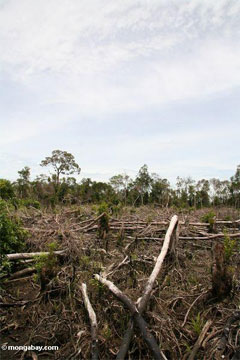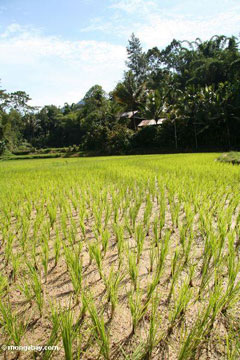Climate change could worsen food shortages in Indonesia by delaying the onset of monsoon rains reports a new study published in Proceedings of the National Academy of Sciences (PNAS). The findings suggest that the country could face increasing risk of drought and forest fire if nothing is done to control rising greenhouse gas emissions.
Using climate models from the Intergovernmental Panel on Climate Change, a team of researchers led by Rosamond L. Naylor of Stanford University forecast that the probability of a 30-day delay in monsoon onset will rise from 9—18% today to 30—40% in 2050, with more rain falling in late in the crop year. Such delays would have a significant impact on food production in Indonesia where agriculture is “strongly influenced by annual and interannual variations in precipitation, caused by the Austral—Asia monsoon and El Niño—Southern Oscillation (ENSO) dynamics.”
“During a bad El Nino event, farmers literally wait months before they can plant their crop, resulting in a harvest that is months late and often much smaller in size”, said Naylor, who is Director of the Program on Food Security and the Environment at Stanford.
“Most models predict that the rains will come later in Indonesia, it will rain a little harder once the monsoon begins, and then it will really dry up during the summer months… Indonesia could be looking at a much shorter rainy season, with an almost rainless dry season in some areas, squeezing rice farmers on both ends,” she added.
 In the future, less rice for the effort. Photo by R. Butler. |
Indonesia has long experienced climate variability, but its effects are increasingly amplified by large-scale land use change, namely deforestation, and massive annual forest fires that have been linked to lower levels of precipitation. Studies in Borneo suggest that dramatic ecological changes are underway in some of the country’s most biodiverse forests, as drought stress and the effects of fires take a toll on the forest ecosystem and resident species.
For people, the changes increase the likelihood of crop failure. Naylor and colleagues estimate that a 30-day delay in monsoon rains reduces rice production by 580,000 metric tons in West/Central Java and 540,000 metric tons in East Java/Bali.
“Production declines of these magnitudes, when scaled up to the country as a whole, are at the upper end of what is typically experienced during major El Niño events, such as in 1997/1998 when Indonesia imported 5.8 million metric tons of rice: 20% of the total world rice trade that year,” the authors write.
 Rice fields in Sulawesi, Indonesia. Photo by R. Butler. |
Naylor and colleagues say the results show the need to develop “adaptation strategies in Indonesian rice agriculture, including increased investments in water storage, drought-tolerant crops, crop diversification, and early warning systems.”
“Agriculture is central to human survival, and is probably the human enterprise most vulnerable to changes in climate”, Naylor explained. “This is particularly true in countries such as Indonesia, with large populations of rural poor. Understanding the current and future effects of changes in climate on Indonesian rice agriculture will be crucial for improving the welfare of the country’s poor”.
“From a scientific perspective, its imperative that we now replicate this kind of study elsewhere, in order to start building a more complete picture of the effects of climate change on agriculture,” Naylor concluded.
Naylor’s team plans a similar study in China later this year.
CITATION: Rosamond L. Naylor, David S. Battisti, Daniel J. Vimont§, Walter P. Falcon, and Marshall B. Burke (2007). Assessing risks of climate variability and climate change for Indonesian rice agriculture. PNAS Early Edition May 1, 2007 www.pnas.orgcgidoi10.1073pnas.0701825104